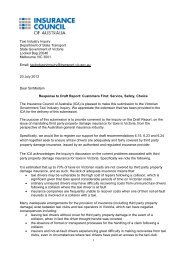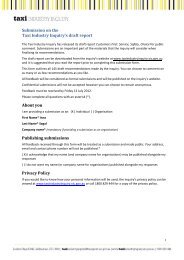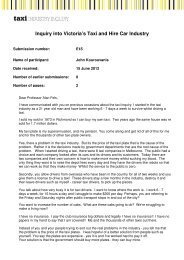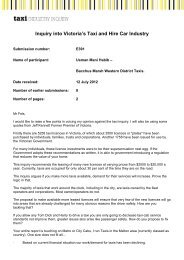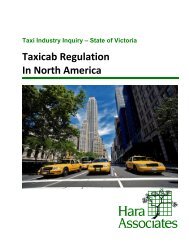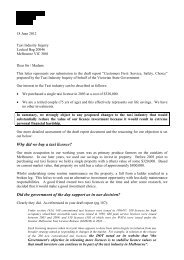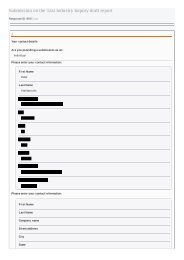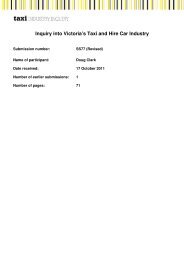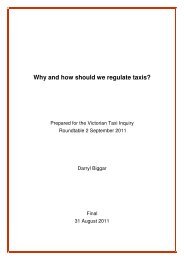Part D â Understanding and improving industry performance (PDF ...
Part D â Understanding and improving industry performance (PDF ...
Part D â Understanding and improving industry performance (PDF ...
You also want an ePaper? Increase the reach of your titles
YUMPU automatically turns print PDFs into web optimized ePapers that Google loves.
Secondly, the inquiry presents its analysis <strong>and</strong> findings on<br />
the effects of key regulations that apply to taxis, hire cars<br />
<strong>and</strong> other point-to-point services. The key regulations<br />
discussed in this section are:<br />
• Restrictions on entry<br />
• The assignment of taxi-cab licences<br />
• Zoning<br />
• Fare controls on taxi services<br />
• Restrictions on competition between taxi, hire car<br />
<strong>and</strong> other forms of private or public transport.<br />
Safety-related regulations (including regulations relating to<br />
the age of vehicles) are discussed separately in chapter 17.<br />
10.1. Markets for taxi-cab, hire car<br />
<strong>and</strong> other services<br />
The licensing regulations imposed by the Victorian<br />
Government have a range of effects on the <strong>industry</strong>’s<br />
structure <strong>and</strong> on the conduct of <strong>industry</strong> participants.<br />
The regulations have a significant influence on how the<br />
<strong>industry</strong> is organised to produce point-to-point transport<br />
services (the market structure), as well as on the kinds<br />
of conduct that licensees are allowed to undertake.<br />
Consequently, they have a significant impact on<br />
competition <strong>and</strong> market <strong>performance</strong>.<br />
The inquiry has assessed this impact in the context of<br />
the relevant markets in which point-to-point transport<br />
services are supplied. A market is defined simply as the<br />
area of close substitution between firms. Competition<br />
can occur in a number of market dimensions, including<br />
differentiation of services (product market) <strong>and</strong> across<br />
different geographic areas (geographic market).<br />
10.1.1. Market segments<br />
Generally, it is helpful to define markets by considering<br />
the activities undertaken by the firms whose conduct is<br />
being analysed. 1 Both taxi-cabs <strong>and</strong> hire cars provide a<br />
service offering flexibility of pick-up point <strong>and</strong> destination,<br />
as well as privacy <strong>and</strong> seating for all passengers. Taxi<br />
services may be acquired in different ways, with three<br />
market segments traditionally being identified:<br />
• The ‘hail’ segment – where taxi-cab drivers pick up<br />
customers from the street after being hailed<br />
• The ‘rank’ segment – where customers queue at a<br />
designated point for pick up (a taxi-cab rank)<br />
• The ‘pre-booked’ segment – those cabs that are<br />
booked by phone <strong>and</strong> dispatched to drivers via a<br />
booking service. In recent times, the growth of mobile<br />
phones <strong>and</strong> smartphone applications has given this<br />
segment an additional boost, with direct-to-driver<br />
bookings now possible.<br />
Although taxi-cabs supply services in all three segments,<br />
the prospects for competition between service providers<br />
vary between the different segments. For example, in the<br />
pre‐booked segment, the potential exists for a much greater<br />
degree of price competition. Hire cars are constrained to<br />
operating only in this market segment <strong>and</strong>, in the absence<br />
of further regulation, strong competition could be expected<br />
between taxis <strong>and</strong> hire cars for pre-booked work.<br />
Other forms of commercial passenger vehicle transport<br />
provide services that are likely to be substitutes to varying<br />
degrees for taxi services. These include other private <strong>and</strong><br />
public commercial passenger vehicles: hire cars, buses,<br />
trams <strong>and</strong> trains.<br />
It is difficult to further analyse substitutability without<br />
considering the effect of the current regulations. The best<br />
example is provided by examining whether hire cars <strong>and</strong><br />
taxis offer substitutable services. It is clear that, in principle,<br />
hire cars are likely to be a very close substitute to taxi-cabs<br />
as both offer a door-to-door service. But regulation limits the<br />
degree with which the two services can compete. Hire cars<br />
may only operate in the pre-booked market segment <strong>and</strong><br />
have different quality requirements (such as those imposed<br />
in relation to vehicle quality), which have resulted in hire cars<br />
becoming a higher quality, more expensive service option.<br />
Other kinds of hire car service – such as wedding cars – are<br />
more specific-purpose in nature <strong>and</strong> therefore unlikely to be<br />
highly substitutable with taxis or hire cars.<br />
1 See comments of French J in Re Singapore Airlines Limited v<br />
Taprobane Tours WA Pty Ltd [1991] FCA 621; (1992) 14 Atpr 41-159<br />
(1991) 104 ALR 633 (1991) 106 ALR 115 (1991) 33 FCR 158 (12<br />
December 1991). “In any given application it [a market] describes<br />
a range of economic activities defined by reference to particular<br />
economic functions (e.g. manufacturing, wholesale or retail sales), the<br />
class or classes of products, be they goods or services, which are the<br />
subject of those activities <strong>and</strong> the geographic area within which those<br />
activities occur”<br />
178





